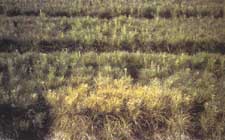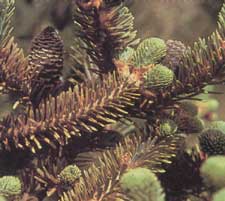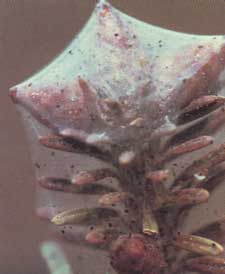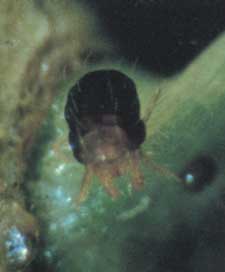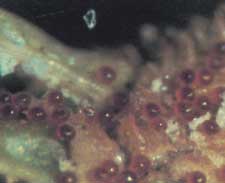Spider MitesRobert P. Ford - Entomologist, Northeastern Area, USDA Forest Service, St. Paul, MN, and Cordell C.E., Anderson R.L., Hoffard W.H., Landis T.D., Smith R.S. Jr., Toko H.V., 1989. Forest Nursery Pests. USDA Forest Service, Agriculture Handbook No. 680, 184 pp. Hosts Spider mites (family Teranychidae) attack most species of trees and shrubs. Nursery seedlings and windbreak trees are particularly susceptible because they are often treated with insecticides that kill predators of spider mites. Pine, hemlock, spruce, juniper, fir, and white-cedar are often heavily attacked. Some tree species are attacked by more than one species of spider mite. The most important species on nursery seedlings are the spruce mite (Oligonychus ununguis ), the conifer spider mite (0. coniferarum), and the southern red mite (0. ilicis). Distribution Spider mites are distributed nationwide across the range of their hosts. Damage Heavy infestations of spider mites cause reduced seedling growth, along with foliage yellowing or browning (fig. 51-1). Although most spider mite attacks do not cause seedling mortality, they may predispose trees to attack by insects and fungi or to damage by adverse environmental conditions. Diagnosis Leaves infested by spider mites have a pale, washed-out appearance (fig. 51-2). Heavy infestations and reccurrent attacks during hot, dry summers cause defoliation. Look for mottled or stippled spots on the shoots or leaves and, in severe cases, fine webbing that has collected dust and pieces of mite eggs (fig. 51-3). If an infested branch is shaken over a white paper, the mites fall onto the paper, where they look like tiny red, yellow, or green mobile specks.
Spider mites usually overwinter as eggs on conifers or evergreens and as adults on deciduous plants. In early spring, the mites become active and feed on plant cell sap. Spider mites go through several stages-egg, larva, protonymph, and deutonymph-before developing into male or female adults. These stages are completed in 4 to 12 days, depending upon weather conditions. There may be several generations in the spring and several more in the fall. Spider mites survive hot weather during the summer by remaining dormant in the egg stage. Control Biological - Lady beetles, which can be purchased in gallon containers from several biocontrol companies, can help control mite populations. Release lady beetles or encourage their propagation by reducing the use of insecticides and establishing a variety of plants in nursery borders. Predatory mites, an anthrocorid bug, and predaceous thrips also afford some natural biological control of spider mites. Cultural - During the growing season spray the foliage with water under pressure to dislodge mites and eggs. Proper irrigation will also stimulate seedling growth and reduce mite damage. Use a variety of tree species in windbreaks. Avoid planting host species such as pine, cedar, hemlock, fir, juniper, or spruce adjacent to windbreaks of the same species. Chemical - Dicofol or an equivalent, such as propargite, demeton, or oxydemeton-methyl, can be applied, when needed, at 4- to 12-day intervals. Use a hydraulic sprayer to wet the entire plant. Avoid using insecticides that kill predatory insects. Alternate miticides to minimize the development of acaricide-resistant mites. Spider mites can tolerate most insecticides. Most miticides do not kill spider mite eggs; consequently, an application of an ovicide such as ovex may also be needed. Selected References Johnson. Warren T.; Lyon, H.H. 1976. Insects that feed on trees and shrubs. Ithaca, NY: Cornell University Press: 100-105. 418-421. U.S. Department of Agriculture, Forest Service. 1985. Insects of eastern forests. Misc. PubI. 1426. Washington. DC: U.S. Department of Agriculture : 30-31. |
Forest Pests: Insects, Diseases & Other Damage Agents |

|
|
